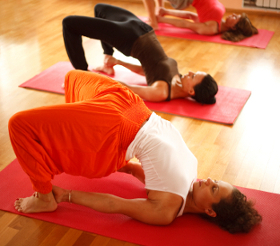Yoga Shows Benefits to Quality of Life in Some Breast Cancer Patients

While some recent research has shown that yoga is associated with improvements in overall quality of life (QOL) and other emotional symptoms, Alyson B. Moadel, Ph.D., Associate Professor of Clinical Medicine at Albert Einstein College of Medicine, and colleagues, wanted to look specifically at a multiethnic sample of breast cancer patients. In a study published in the Journal of Clinical Oncology and supported by a grant from the National Cancer Institute*, Dr. Moadel examined whether yoga can support and/or preserve QOL better than standard care using standard based QOL measures with an ethnically diverse group of breast cancer patients in an underserved area of New York City.
Participants were randomized in a 2:1 ratio to either a yoga intervention group or a waitlist control. QOL was examined at baseline, 1 month, 3 months, and 6 months. The yoga intervention, based on Hatha techniques, consisted of 1.5 hour classes once a week for 12 weeks, which is a schedule that has been found efficacious in other studies. Participants were 42% African American, 31% Hispanic, and 23% White.
The yoga intervention consisted of physical stretches and poses, breathing exercises, and meditation. Patients were also asked to practice yoga at home daily and were given materials for guidance. Study measures were assessed using several well established reporting tools. The Functional Assessment of Cancer Therapy (FACT) was used to measure patients' reports of QOL in the areas of physical, social, emotional, and functional well being, and was administered in an interview format. Several other measures were used including the Functional Assessment of Chronic Illness for Fatigue and Spirituality to assess change in those components. The Distressed Mood Index was used to measure distressed mood symptoms in domains such as “anxious/sad,” “irritable” and “confused.” Participants’ attendance at yoga classes was recorded by instructors, while home practice was self-reported.
Results showed that participants in the control group reported a greater decrease in social well being than participants in the intervention group (13% vs. 2%). This lack of improvement in social well-being notwithstanding, study authors noted that yoga may serve to promote a sense of social support and connection in participants. Given that many of the patients were receiving cancer treatment, the authors speculated that the effects of the intervention may have been obscured by the relatively impaired QOL of the participants, as compared to other comparable groups of patients.
Secondary analyses of patients not on chemotherapy indicated that those in the yoga group showed improvement in emotional well being and decreased distress after 3 months. The control group experienced marked deterioration in overall QOL, social well-being, and distressed mood.
Throughout the study, weekly class adherence was low. Of the 108 participants included in the final sample for analysis (84 intervention and 44 waitlist control) class attendance ranged from zero to 19 classes attended. One third of intervention group participants did not attend any classes, though eight of these patients reported practicing yoga at home at least a few times per week. The mean number of classes attended by participants was 7, and 61% practiced yoga at home at least a few times per week. The authors shared that this data does reflect natural adherence as no compensation was provided, but the lack of attendance could show that this type of program is not feasible for some patient groups.
At 3 month follow-up, it was found that high class adherers (> 6 classes; n=33) were found to have higher energy levels and physical well being than low adherers (1 to 6 classes; n=24) and non-adherers (0 classes; n=27). There was also significant interaction between adherence and baseline distressed mood. “Attending the intervention at any level was related to improved mood regardless of one's initial distress level, whereas not attending among those with low distress was related to worsening mood,” the authors noted.
While this study led to low class adherence, participants still chose to practice at home and did show some benefits in emotional wellbeing, especially for participants not receiving chemotherapy. Authors stated that future studies could use comparison control groups such as a support group or an exercise group to help discern what therapeutic factors are operating in yoga, such as social support, poses, or meditation. Given the low cost of yoga and the ability to practice at home at any time of day, it is an intervention that could have interesting impacts on cancer care and merits future study.
For more information, view the study online: http://www.ncbi.nlm.nih.gov/pubmed/17785709
*5R03CA088598





